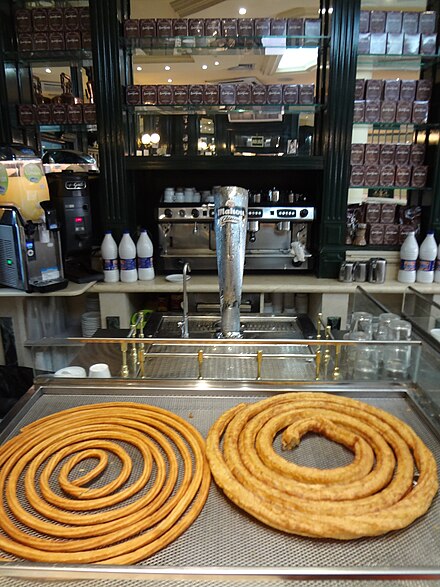Madrid - capital city of Spain
For other places with the same name, see Madrid (disambiguation).
Madrid is Spain's capital and largest city, with over 3.2 million residents within the city limits and 6.8 million people live in the autonomous Community of Madrid region (as of 2018). A city that has been marked by Spain's varied and tumultuous history, Madrid has some of Europe's most impressive cultural and architectural heritage, which includes grand avenues, plazas, buildings and monuments, world-class art galleries and museums, highly popular football teams, and cultural events of international fame for everyone. Madrid is also renowned for gastronomic delights and a nightlife lasting up until dawn.
Despite its size, numerous assets, and the fact that it's the capital of Spain, Madrid is more often than not disregarded by tourists that gravitate to other parts of the country. But though it may appear to lack some of the breathtaking architecture of Barcelona, or the frenetic energy of London and Berlin, Madrid is a massive treasure chest that has something for those who are willing to get off the beaten tourist tracks. It might not be the most sought-after city, but those who seek out what Madrid has to offer will discover a city of unexpected beauty.
Districts
The main tourist areas
Sol, Letras and Lavapiés (Sol, Letras, Lavapiés)
Containing the symbolic centre of the city, an important shopping and social meeting area; the writers' quarter with a high concentration of bars, pubs, restaurants and hotels; and the multicultural quarter with a large population with African, Asian or Latin American roots, world music bars, alternative theatres and art galleries.
La Latina and Austrias (La Latina, Austrias)
Madrid's "old town": a typically Mediterranean quarter, characterised by narrow lanes and colourful buildings from the 18th century, its history going back to the Moorish era. This is the place to go for tapas, stylish bars full of bohemian young people and Madrid's biggest flea market. The palace quarter is dominated by the royal residence and representative buildings from the Golden Age of the Spanish Empire.
Retiro and Paseo del Arte (Retiro)
East of the city centre. Parque del Buen Retiro is a huge urban park, one of the green lungs of Madrid, dating back to the imperial age. The Paseo del Arte—or "museum triangle"– is where Madrid's most famous museums and art collections are found, a must-go for all those who want to see the works of El Greco, Velázquez, Goya, Picasso and Dalí.
The rest of the city
Understand

Location
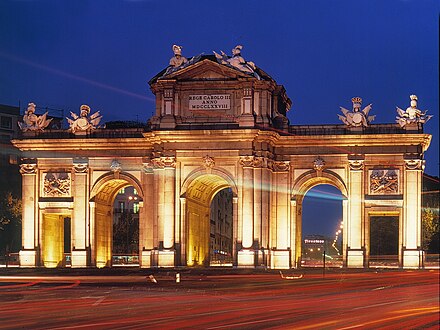 Madrid is just northeast of the geographical centre of the Iberian Peninsula, in the middle of the Spanish central Castillian plateau (Meseta central), at an average altitude of . Nearly all of the most famous tourist areas are in the centre of the city including Puerta del Sol, Plaza Mayor, Palacio Real, and Plaza de Colón. The major streets in Madrid include the Gran Via, Alcalá Street, and Paseo de la Castellana.
Madrid is just northeast of the geographical centre of the Iberian Peninsula, in the middle of the Spanish central Castillian plateau (Meseta central), at an average altitude of . Nearly all of the most famous tourist areas are in the centre of the city including Puerta del Sol, Plaza Mayor, Palacio Real, and Plaza de Colón. The major streets in Madrid include the Gran Via, Alcalá Street, and Paseo de la Castellana.
Climate
The climate of Madrid is continental, mainly dry and quite extreme at times. Madrid experiences a characteristically hot and dry summer, along with a fairly cold winter with frequent frosts during the night and occasional snowfalls. Spring and autumn are generally mild with the most rainfall concentrated in these seasons. Spring and autumn are definitely the best times to visit, especially the months of April, May, June, September and October. There is very little rainfall during summer and also less rainfall during winter. During winter, snow occurs sporadically; however, snow usually lasts only for a few days, but there is abundant snowfall in the adjacent mountain ranges nearby.

History
 Madrid is a city that goes back to the Spanish Muslims, but virtually nothing of Madrid before the Reconquista is left. A few historic city walls have been archeologically preserved but Madrid was by far overshadowed by Toledo (Roman Toletum) until the early modern era. To give just one example, construction on Madrid Cathedral did not start until the late 19th century, and only finished in the 1990s, as the archbishop of Toledo did not want to relinquish episcopal power, and the monarchs had moved the capital in part precisely to escape the power of Toledo's archbishop.
Madrid is a city that goes back to the Spanish Muslims, but virtually nothing of Madrid before the Reconquista is left. A few historic city walls have been archeologically preserved but Madrid was by far overshadowed by Toledo (Roman Toletum) until the early modern era. To give just one example, construction on Madrid Cathedral did not start until the late 19th century, and only finished in the 1990s, as the archbishop of Toledo did not want to relinquish episcopal power, and the monarchs had moved the capital in part precisely to escape the power of Toledo's archbishop.
The culture of Madrid was dominated by its royal history, centre of the Spanish Empire. The Royal Palace, big plazas and buildings used by the Spanish Monarchy, enormous cathedrals and churches are plentiful in Madrid. Madrid is now just as much a cosmopolitan city as Berlin or London: full of modern architecture, lifestyle and culture.
Madrid became capital of Spain under Philip II who had a gargantuan palace built in nearby El Escorial. For a long while, Madrid would be the royal residence first, only becoming a city much later. Madrid architecture often reflects the era in which it was built. The Spanish Habsburgs ("Los Austrias") who reigned until the death of unfortunate Charles II in 1700 predominantly used red brick for facades and black schist for the roofs. The later Bourbon dynasty (ruling today after the two Republican interludes) preferred granite to brick, giving their buildings a greyer tone. The king that had the largest influence on Madrid after Philip II was perhaps Charles III. He was nicknamed "el Rey Alcalde" (the mayor-king) or "Madrid's best mayor" due to his extensive building and modernisation programmes in the city. Other royal projects that left their mark are Isabel II's freshwater canal, and the metro which was started in 1919 with King Alfonso XIII's own money. However, both those monarchs were so unpopular that they were later overthrown by their own people, giving rise to the First and Second Spanish Republics.
Being the capital of Spain, Madrid came to be associated - justly or not, for better and for worse - with the governing trends in Spain by Spaniards in other parts of the country. As the governing trends swung widely from anti-clerical Republic to hyper-catholic fascist Franco dictatorship, this has influenced the perception of Madrid in the rest of Spain. During the 2nd Republic (1931-1936), it was a bustling city of new ideas with many political issues of the day literally fought out on the streets of Madrid. During the Civil War, Madrid endured a three year siege (1936-1939) by the anti-Republican troops and was one of the last places to hold out for the Republic. During the dictatorship of Francisco Franco (1939-1975), the city represented the heart of the repressive hyper-conservative dictatorship to many Spaniards, particularly Basques and Catalans. However, the city is also the epicentre of the famous Movida of the 1980s, a Spanish movement that bred personalities such as the director Pedro Almodóvar. The heritage of this era is indeed still visible in the city centre, where a party can be found at all times and one of the most liberal and colourful environments of Spain can be seen. The city is also known for its acceptance of LGBT people.
Modern politics
Since Franco's death, Madrid's city politics have swung widely from right to left and back, at first having a (socialist) PSOE-led government through the 1980s which was replaced by the centre-right PP which dominated the city through an awkward mix of paternalistic public works, free-for-all housing plans, and other anarchic construction projects in the 1990s. The 2000s saw a more nuanced approach by Alberto Ruiz-Gallardón, also of the PP, who focused on upgrading Madrid's ring road (the M30), expanding the metro system, and liberalising the economy. The 2008 financial crisis hit Madrid hard, which gave rise to ex-communist Manuela Carmena in the 2010s. Despite showing early promises, Carmena's popularity dwindled, and the PP's José Luis Martínez-Almeida ousted her as mayor by winning the 2019 elections forming a governing coalition with two new political parties: the centrist Ciudadanos and the far-right Vox. This rightwards shift reinforced itself with the popularity of Isabel Diaz Ayuso, the PP president of the Community of Madrid.
Madrileño everyday life
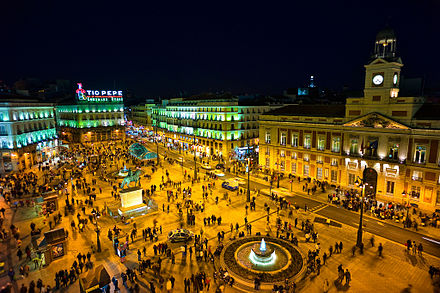 The citizens of Madrid refer to themselves as Madrileños or the more traditional and now seldom-used term "gatos" (cats). They live by a daily routine that is heavily influenced by the climate. Due to the typically midday heat during summer, a "siesta" can be still observed during which some citizens take a break to cool off, though Madrileños can usually only afford this 'luxury' during holidays and weekends.
The citizens of Madrid refer to themselves as Madrileños or the more traditional and now seldom-used term "gatos" (cats). They live by a daily routine that is heavily influenced by the climate. Due to the typically midday heat during summer, a "siesta" can be still observed during which some citizens take a break to cool off, though Madrileños can usually only afford this 'luxury' during holidays and weekends.
Most stores are open throughout the day; just small stores are often closed during siesta. Workers and those more afflicted by Western lifestyles choose not to observe this long break and work usually between 09:00 and 18:00-19:00. However, during summer, many offices have a summer schedule requiring workers to start at 08:00 and finish at 15:00 (most commonly without the standard 1-2 hour break for lunch).
Offices usually close over the weekend but businesses are often open Saturday morning, or until the afternoon in the city centre. Most grocers are closed on Sundays, but some major chain and department stores linked to "culture" (books, music, etc.) will be open every day. Shops and department stores in Puerta del Sol area are open every day.
Madrid has a very modern and elaborate transportation network of buses and Metro with a few "Light Metro" tram lines in the outskirts. The city contrasts with some large European cities in that it is extremely clean, and city employees in bright yellow vests can almost always be seen cleaning the streets and sidewalks. Like most large cities, however, there is a substantial population of vagrants and beggars lining the streets.
Madrid is one of the biggest and most cosmopolitan cities in Europe. Communities of West Africans, North Africans, other Europeans (especially Romanians), Chinese, Filipinos, Pakistanis, and above all Latin Americans are prominent.
Nightlife
Madrid possibly has the most bars per capita of any European city and a very active nightlife; Madrileños are known to stay up until as late as 05:00-07:00. It is quite common to see a crowded Gran Vía on weekend nights. Due to this lifestyle, lodging near the fun areas may end up a nightmare for light sleepers if your window faces the street.
Get in
By plane

Main article: Madrid–Barajas Airport
Madrid Barajas International Airport (IATA: MAD), 40.472222°, -3.560833°. All commercial flights into Madrid use this airport, which is 13 km north-east of the city. There are direct flights from most major cities in Spain and across Europe, several from the Americas as well as a few African and Asian connections.
There are two terminal complexes, widely separated: Terminals 1, 2 & 3, and Terminals T4 & T4S. To transfer between them land-side use the free shuttle bus. It runs 24 hours, every 5 min daytime, and takes 10 min between T1 and T4. You can also take it just between T1, T2 and T3, but it's as quick to walk. Between T4 and T4S, use the automated train. The metro also connects the two complexes but you'd have to buy a ticket for €3. There are other transfers air-side for connecting passengers, enquire at the airline transfer desk, but they will probably involve collecting your checked bags in the hall and lumping them onto an internal navette to the other complex.
All the terminals have the usual full range of passenger facilities land- and air-side. 2018-05-04
Madrid has two smaller airfields, Torrejón and Cuatro Vientos, but they have no commercial flights.
To and from the airport
- By day, Metro is the best way to reach city centre. Line 8 (pink) runs from Nuevos Ministerios to Terminals 123, Barajas town (no airport here, don't get off!) and T4. It runs from 06:00 to 01:30, taking 15 min from city to T123 and another 5 min to T4. The single fare is €5. See "Get around" for other ticket options.
- The Renfe regional train service C1 line runs between T4 and Puerta de Atocha, without needing to change trains. Puerta de Atocha is nearby but separate to Atocha metro station.
- If taxis are your thing, there is always an armada of them readily available. There are fixed fares for Madrid proper.
Buses between city centre and airport are:
- Exprés Aeropuerto bus 203 runs from Atocha to T12 & T4, 06:00-23:30 every 15-20 min, taking 30 min.
- Bus 200 runs from Avenida de America transport hub to T12 & T4 (but T3 only city-bound, not outbound), 05:00-23:30 every 10-20 min.
- At night bus N27 runs every 35 min from Cibeles to T12 & T4 and is the only public transport option.
- Direct buses elsewhere include:
- Bus 101 from Canillejas transport hub, east edge of the city, to T12 (T3 only city-bound, not outbound).
- Bus 822 from Coslada and San Fernando de Henares, just south of the airport, to T1.
- Bus 824 from Alcalá de Henares and Torrejón to the east, to T12.
- Bus 827 & 828 from the Autonomous University and Alcobendas, to T4.
- Avanza buses run to T1 from Avila and Salamanca.
- Alsa buses run to T4 from Zaragoza, Barcelona, Valladolid, León, Murcia, Alicante, Gijón, Oviedo, Lugo, Coruña, Santiago de Compostela, Burgos, Vitoria, San Sebastián, Santander, Bilbao, Logroño and Pamplona.
- Socibus run to T1 from Andalusia, e.g. Córdoba, Cádiz, Jerez and Sevilla.
By train
The state-owned rail company Renfe (+34 902-240-202 ) and Ouigo operate trains to Madrid. Frequent long-distance trains connect Madrid and Alicante (2 hr 30 min), Barcelona (2 hr 40 min), Bilbao (6 hr), Córdoba (2 hr), Malaga (2 hr 30 min), Salamanca (2 hr 30 min), Santiago de Compostela (6 hr), Seville (2 hr 20 min), Valencia (2 hr) and Zaragoza (1 hr 15 min).
The overnight train from Lisbon was suspended in 2020, perhaps indefinitely. Travel from Portugal now involves changing at Merida and Badajoz.
There is a direct daytime train from Marseille, taking 8 hours. Madrid can be reached from Paris and other cities in France and beyond also by changing in Barcelona. However for the French Atlantic coast (e.g. Bayonne and Bordeaux) it is quicker to travel via Hendaye.
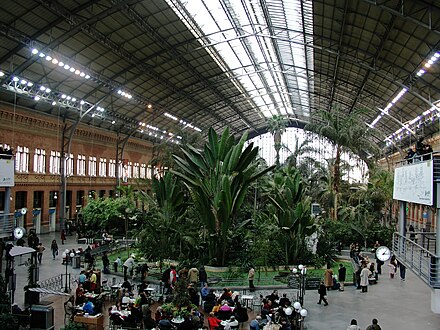
Madrid has two mainline railway stations, Atocha and Chamartín, both with extensive Metro and local Cercanías train connections. To transfer between them, take Metro line 1 (€1.50, 30–40 min) or Cercanías lines C3 and C4 (€1.35, 15 min).
Most mainline trains run from:
- Puerta de Atocha (Estación de Atocha), 40.405807°, -3.689688°. 1 km south of city centre, it's divided into two main sections, for mainline and for Cercanías trains. The mainline part is set inside the towering old station building, where the former track area has been converted into a retail & food mall, along with a tropical garden with a pond full of small turtles. The Cercanías part, adjacent, has a memorial to the victims of the terrorist attack of 11 March 2004. Although both parts require tickets from passengers to access the platforms, the mainline part also has airport-style security screening checkpoints for departing passengers so make sure you arrive at the station well ahead of your train’s departure time to reduce the risk of missing it due to long security queues. Knives longer than 6 cm are not allowed onboard, will be confiscated and maybe destroyed. This especially applies for train to Barcelona. 2018-05-06
- Estación de Madrid-Chamartín, 40.472222°, -3.682222°. This station is 4 km north of city centre on Metro lines 1 (blue) and 10 (dark blue). Chamartín has more direct services than Atocha for north-west cities such as Bilbao, Leon, Santiago and Salamanca, and the Lisbon sleeper also runs from here. Facilities at this station include a tourist information centre, post office, hotel, car hire, shops and luggage storage. 2018-05-06
By bus
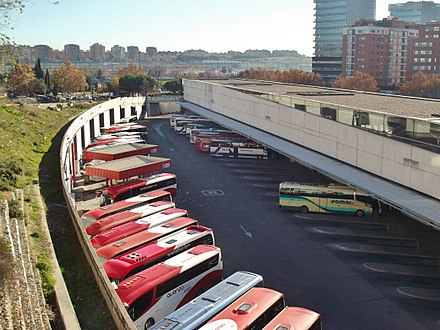
International buses, and those headed south of Madrid, run from Estación Sur de Autobuses 📍 (C/ de Méndez Álvaro, 3, +34 914 684 200 ) which is 1 km southeast of Atocha. Routes include Lisbon (3 per day, 8 hr, by Avanza), Milan (twice a day, 26 hr, by Alsa) and Paris (daily, 16 hr, by Flixbus). The metro stop is Méndez Álvaro on line 6 (grey). It also has a Cercanias train halt. The building is quite old, but adequate, with several bus company ticket offices, a retail corridor with a couple of cafes, and toilets.
Buses to the north, e.g. Barcelona and Bilbao, run from Estación de Avenida de América 📍 (Avda de América, 9), 2 km northeast of the centre. It's a big transport hub on metro lines 4 (brown), 6 (grey), gold (7), and 9 (purple). It's not on a Cercanias line.
Get around
By public transit
Madrid proudly sports one of the best public transportation networks in the world and the second largest metro network in Europe after London's. Buses and subways work with the same tickets, and operate within the integrated transit network of CRTM 📍 (Plaza del Descubridor Diego de Ordás 3, M-F 08:00-20:00).
A single ticket for Zone A costs €1.50 (max. 5 stations), but the cost goes up to €2 if you go more than 10 stations, and can be purchased from metro ticket vending machines or directly from the bus driver on entry. A ten-trip ticket (10 viajes) costs €12.20 for Zone A (no transfers from one mode of transportation to another allowed), or €18.30 (including all transfers within 60 min); these tickets can be shared with other travellers. Children under the age of 4 may travel without a ticket, and children under 11 receive a 50% discount. Tickets can be purchased at metro stations, newsstands, and tobacconists.
If you plan to use public transport a lot you can purchase a Tourist Card, which allows unlimited travel as well as discounted admission for some tourist attractions. The card can be purchased at any metro station, as well as at the CRTM headquarters. For travel within Zone A the following rates apply: 1 day (€8.40), 2 days (€14.20), 3 days (€18.40), 5 days (€26.80), or 7 days (€35.40). These tickets are personalised so cannot be shared.
If you're planning on staying for a long time, you might consider investing into the Tarjeta Transporte Público. You can load travel plans onto them according to your age – regular (adult), joven (youth) or mayor (senior). Application must be made in advance at any metro station with a completed application and a copy of your passport. The travel plans can be loaded from any metro vending machine.
Metro
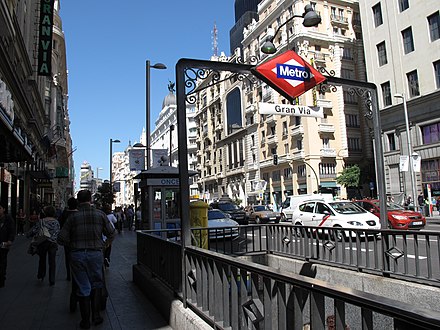 The Metro de Madrid (Madrid's subway/underground) is one of the best and least expensive metros in Europe. In 2019 Metro celebrated its 100th anniversary with exhibitions and displays at stations commemorating its century of history. The Metro's underground tunnels can provide relief from the sun on hot days. The metro network had one of the most rapid expansions of any rapid transit networks in a modern western nation in the 1990s only brought to a temporary halt with the late 2000s financial crisis. To give just one example, on April 11 2003 over 40 km of new metro tunnel were opened in a single day - more than what New York City and Berlin combined have opened in the 21st century thus far.
The Metro de Madrid (Madrid's subway/underground) is one of the best and least expensive metros in Europe. In 2019 Metro celebrated its 100th anniversary with exhibitions and displays at stations commemorating its century of history. The Metro's underground tunnels can provide relief from the sun on hot days. The metro network had one of the most rapid expansions of any rapid transit networks in a modern western nation in the 1990s only brought to a temporary halt with the late 2000s financial crisis. To give just one example, on April 11 2003 over 40 km of new metro tunnel were opened in a single day - more than what New York City and Berlin combined have opened in the 21st century thus far.
Ticket machines are bilingual with instructions in both Spanish and English. Swiping the smartcard once allows you to use the metro network as long and far as you like – but make sure you stay inside the Metro zone, as once you leave it you'll have to swipe your smartcard again. If you are travelling in the city centre, then multiple people can tap in using the same Multi card; they don’t have to buy their own individual card. However, some outlying stations as well as airport stations have another check at the exit where you have to "tap out" because the fare from central Madrid is higher. Should you go there more than once, buy the "ten trip all network" ticket (which is slightly more expensive than the "ten trip central area" ticket) or a day ticket. When you travel to/from airport stations, there is additional supplement of €3, which can be paid at the entrance or exit. The tourist passes do not require this supplement as it is included in the price.
Generally the Metro operates daily from 06:00-01:30, although you can catch some trains as late as 02:00. Frequencies range from 2-4 minutes during rush hour to up to 15 minutes from midnight onwards.
Bicycles are permitted on the Metro during most periods except during rush hour, generally M-F 07:30-09:30, 14:00-16:00, and 18:00-20:00. Pets in carriers and dogs are also permitted.
Pickpockets are rife on the metro, and travellers should take appropriate precautions. Announcements in Metro trains and stations are made mostly in Spanish only, though some signs are bilingual in Spanish and English.
Bus
 Whatever the Metro doesn't cover, EMT buses do. Generally buses run 06:00-24:00. Búho (owl) night buses have their main hub at Plaza de Cibeles 📍, covering most of the city at roughly 20-minute intervals.
Whatever the Metro doesn't cover, EMT buses do. Generally buses run 06:00-24:00. Búho (owl) night buses have their main hub at Plaza de Cibeles 📍, covering most of the city at roughly 20-minute intervals.
All buses are equipped with free Wi-Fi facility (EMTmadrid), easy to use with any type of laptop or mobile device. For travellers with smartphones, there is a helpful official EMT app for iPhone and Android with a route planner and schedules.
Train
Madrid has a system of local trains called Cercanías that connects outlying suburbs and villages with the city centre. Although most useful for visiting historic or outdoor destinations outside the city core, it is also useful for quickly getting from one end of the city to another, as well as to Terminal T4 📍 of Barajas airport.
Chamartín Cercanías 📍 and Estación de Nuevos Ministerios 📍 are in the north, and Estación de Sol 📍 and Atoche Cercanías 📍 are in the south of the city.
By taxi
 Alongside its metro system, Madrid boasts one of Europe's largest taxi fleets. Taxis are usually plentiful and easy to find, but they become harder to find during late hours on weekends, especially if there is some rain. Unlike in other European cities, there are few taxi stands; just stand by the side of a major road or bus stop and wave your hand to signal an available taxi passing by. Available taxis have a green libre sign in the windshield and a green light on top.
Alongside its metro system, Madrid boasts one of Europe's largest taxi fleets. Taxis are usually plentiful and easy to find, but they become harder to find during late hours on weekends, especially if there is some rain. Unlike in other European cities, there are few taxi stands; just stand by the side of a major road or bus stop and wave your hand to signal an available taxi passing by. Available taxis have a green libre sign in the windshield and a green light on top.
Official taxis are white, and have a red stripe and the flag of Madrid on the front door. The tariff is displayed on top of the car – a 1 during daytime and a 2 at night, which become 2 and 3 on public holidays such as Christmas Eve.
Some taxi drivers will do what is called la vuelta al ruedo — they will drive you around or through the crowded avenues to increase the fare.
Most taxi drivers do not speak fluent English, so you should have the names and addresses of your destinations written in Spanish to show your taxi driver. Likewise, get your hotel's business card in case you get lost. When giving an address to a taxi driver, it is useful to say the name of the neighbourhood in addition to the street name and number, for example: Calle de Don Ramón de la Cruz, 74, Lista.
By car
Cars have been one of the most hot button issues in Madrid municipal politics in the twenty first century. Leftist mayor Manuela Carmena introduced a scheme to drastically reduce the number of cars in central Madrid, however she lost reelection in 2019 and the new right-wing Mayor José Luis Martínez-Almeida reversed course before being forced by European Union legislation they had violated to partially reinstate the ban. In short: driving a car in Madrid can be a nightmare, but not as bad as cities like Paris or Brussels. Parts of the Spanish capital's downtown suffers from the typical problems of most big cities: far too many cars and not enough space to accommodate them. However, you can often see construction works on roads aimed at finding a better balance between cars and buses, and evidence is pointing towards easier coexistence between all modes of transportation. With that said, traffic jams in major arteries like the Paseo de la Castellana can occur deep into the night. The problem is compounded by the narrow streets in the old town, where a lorry delivering beer barrels to a local bar can cause a huge tailback. Finding a parking space can be very time consuming, and difficult if one is not skilled in the art of close proximity parallel parking. Many Spaniards are also lacking in this art, prompting them to simply park in the street, blocking other cars in. If you find yourself blocked in by such a practice, honk your horn until the driver returns. Most Madrileños park by sound alone: they will feel no remorse for repeatedly hitting the car in front and behind them while trying to get into or out of a tight spot. If you value your car's paint job, or you have rented a car, it may be best to park underground. Though this is no guarantee for nobody hitting your car, the chances are somewhat diminished.
For free parking but within walking distance of 20 minutes to Sol, try the street at Principe Pio metro stop. The place to park is the street near to the shopping mall called 'Calle de Mozart'. It is packed with cars on weekday mornings because of people getting to the Metro station. During the evenings and weekends it's easy to get a parking spot.
Renting a car is not only unnecessary, but not recommended for getting around central Madrid, and a car is likely to be more of a liability than an asset. Visitors should make use of Madrid's excellent public transportation instead. Renting a car only makes sense if you are planning to leave Madrid and drive to the nearby towns. That being said, there are car rental facilities available at the airport, train stations, and other main travel sites. Always be sure to have a street map handy! The roads within Madrid are difficult to navigate as there are no places to stop and consult a map or check your route.
There are several consecutive junctions underground near the centre and your GPS may not get a signal underground. Plan your turns before you enter the tunnels.
By bicycle
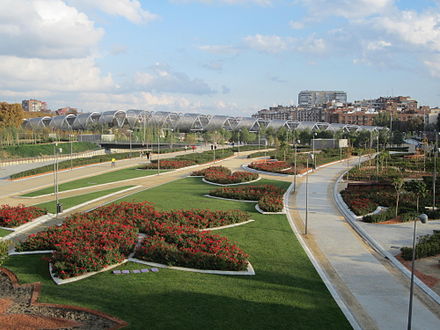 Madrid does not appear as a bike-friendly city at a first sight. Things were changing slowly to make bike experience more comfortable, but in 2019 the new right-wing mayor planned to make the city the only capital in the world where bicycle lanes are being removed. Several streets in the city centre have been transformed into mixed-traffic spaces where pedestrians and bikes have priority over cars. There are new easy-bike paths all along the river and connecting important parks.
Madrid does not appear as a bike-friendly city at a first sight. Things were changing slowly to make bike experience more comfortable, but in 2019 the new right-wing mayor planned to make the city the only capital in the world where bicycle lanes are being removed. Several streets in the city centre have been transformed into mixed-traffic spaces where pedestrians and bikes have priority over cars. There are new easy-bike paths all along the river and connecting important parks.
It is also possible to use a lot of narrow easy streets where traffic is slow and calm to travel along the city without depending on exclusive bike paths. There are some official and unofficial publications with these streets along the web.
To avoid some of Madrid inconveniencies, such as hot weather or slopy streets it is also possible to get bikes on Metro and Railways trains with some schedule restrictions, and on every public transport without restrictions when using folding-bikes.
Madrid's public bike rental service, called BiciMAD. It boasts 1560 electric bikes spread over 123 stations. Unfortunately, the site is not yet available in English. However, the information at the bike stations is available in multiple languages. A casual user pays no initial fee, but €2 for every first hour or fraction, and €4 for the second (Oct 2019). A contactless card is issued instantaneously upon signing up at any bike station. The process is relatively quick and requires some basic information such as name, ID, email and credit card number. Swipe the card through the somewhat larger opening on the left of any bike to retrieve it. Use the buttons to the left of the handlebar to toggle electric assistance. Here you'll also find a button to switch on the lights. So watch out, you'll need to do this yourself when it gets dark! Be equally careful when using electric assistance for the first time, as it might require some getting used to.
There are also some rent shops in the historical centre area such as the company Baja Bikes Madrid. This company offers several rental points in Madrid at Retiro, Atocha, Madrid-Río, etc. They offer guided and self-guided bicycle tours, using electric or conventional bicycles.
- Trixi bike tours, c/Jardines 12, 40.41887°, -3.70076°, +34 915 231 547. Bicycle tours and rental from €4/hr. Daily 11:00 start city bike tours in English for 3 hr, €22.
See
Madrid is one of the top addresses in the world for art, both contemporary and not-so-contemporary, with Goya's most famous works in the Prado, Picasso's Guernica in the Reina Sofía and countless other works in those two museums and the Thyssen-Bornemisza Museum. The Prado goes back to the royal art collection which - for a nation that was the world's leading superpower for two centuries - is of course quite impressive. The Reina Sofía was opened to house what the Prado "had no room for" with a dividing line based on era ultimately being drawn. Besides art, Madrid also boasts some impressive architecture courtesy of kings who had access to the wealth of two continents and no qualms in spending it for extravagant royal residences.
The following is a non-exclusive taste of what Madrid has to offer. Dive into the districts to find more!

- Museum Triangle 📍. This is Madrid's museum district, named for the three major art museums clustered along Paseo del Prado east of the old city: the Museo del Prado, one of the finest art museums in the world, the Thyssen-Bornemisza, a baron's collection of classical art, and the Reina Sofia, Madrid's modern art museum. However, a couple of smaller museums also occupy the neighbourhood which are well worth seeing as well.
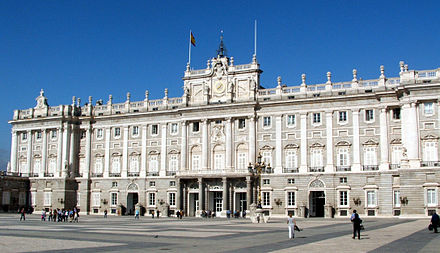
- Royal Palace 📍. An enormous palace, one of the biggest in Europe, with scorching plains of concrete around it. Though it is the official residence of the King of Spain, the royal family does not actually reside here and it is generally used only for state ceremonies. The Royal Palace is considered to be one of the most emblematic and beautiful buildings in Madrid.
- Plaza Mayor 📍. Perhaps the best known plaza in Madrid, this impressive square is now one of the main stops on any tourist visit.
- Puerta del Sol 📍. This plaza is the heart of Madrid and one of the busiest places in the city – a hub for the local transit system, a favourite meeting spot for locals, a visible area for festivals or political demonstrations, and an opportune location for tour guides, street performers, pickpockets and anyone else looking to take advantage of all the tourists on-hand. Several of Madrid's landmarks are found here: the statue of the Bear and the Strawberry Tree, the main Post Office with its iconic clock tower and Kilometre Zero of the Spanish road network.
- Gran Vía 📍. One of the busiest avenues in Madrid, the location of the cinema district and a number of shopping malls and is lined with large billboards and lights.
- Plaza de Cibeles 📍. Large roundabout in the city centre with the neoclassical Cybele Fountain and the imposing eclectic Cybele Palace. Spain's former Palace of Communications is now the seat of the municipal government).
- Mercado de San Miguel 📍. Sets the ambience of a traditional market, with the advantages of the new times. It has an iron and glass structure from the 20th century.
_02.jpg/440px-Catedral_de_la_Almudena_(Madrid)_02.jpg)
- Catedral de la Almudena 📍. The main church of Spanish Catholicism, in neo-Gothic style. Built from the 19th century to the 1990s.
- Plaza de España 📍. A prominent square adjacent to two of the tallest buildings in Madrid: the Torre de Madrid and the Edificio España.

- Parque del Retiro 📍. The main park of Madrid, the perfect place to take a rest during a sunny day, or take part in the drum circles around the statue of Alphonso XII on summer evenings.
- Templo de Debod 📍. Ancient Egyptian temple that was moved to Madrid's Parque del Oeste after the construction of the Aswan High Dam.
Do

Sports
The most known association football clubs are Real Madrid and Atlético de Madrid. Their home stadiums can be found in the Northern Suburbs. They are widely regarded as among the best football teams in the world; catching a game is a must. Other teams include Rayo Vallecano, in the neighbourhood of Vallecas or Getafe in the nearby suburbs, which are served by Madrid Metro.
There are also major basketball teams: Estudiantes, Real Madrid, and Fuenlabrada. The first two play at the Palacio de los Deportes every other weekend during the season. Fuenlabrada, based in the Madrid suburb of the same name, play at Polideportivo Fernando Martín.
Handball is also played in Madrid but the big sports conglomerates of Madrid are no longer involved in the top leagues making BM Alcobendas the highest ranked Handball team from the greater Madrid area.
Cultural venues
 Flamenco shows can be seen in numerous venues in Sol-Letras-Lavapiés, Moncloa and La Latina - Austrias.
Flamenco shows can be seen in numerous venues in Sol-Letras-Lavapiés, Moncloa and La Latina - Austrias.
Opera houses are spread through the city centre. In addition, several orchestras don't have a stable/home venue to play in:
- Orquesta Nacional de España (Spanish National Orchestra), +34 902 224 949 (tickets). Tickets are sold at ticket offices in the Auditorio Nacional de Música, Teatro María Guerrero, Teatro de la Zarzuela, Teatro de la Comedia, and Teatro Valle-Inclán. 2017-02-04
- Orquesta Sinfónica de Madrid (Madrid Symphony Orchestra), C/ Barquillo, 8, +34 915 321 503, osm@osm.es. 2017-02-04
- Orquesta de la Comunidad de Madrid (Community of Madrid Orchestra), C/ Mar Caspio, 4, +34 913 820 680, info@orcam.org. 2017-02-04
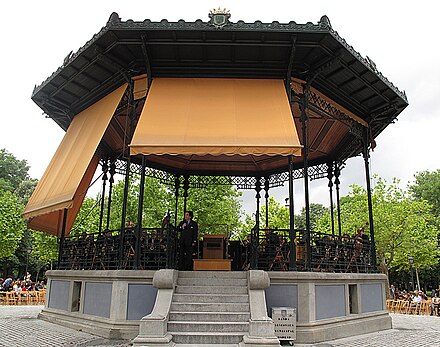
- Banda Sinfónica Municipal de Madrid, +34 915 267 147, +34 915 267 158 (M-F 08:00-15:00), bsinfonica@madrid.es. Performs in El Retiro Park in the summer. Tickets can be purchased at the Teatro Monumental (listed above), at the tourist information centre in Plaza Mayor, and online. €5 (adults), €3 (seniors/youth/children)
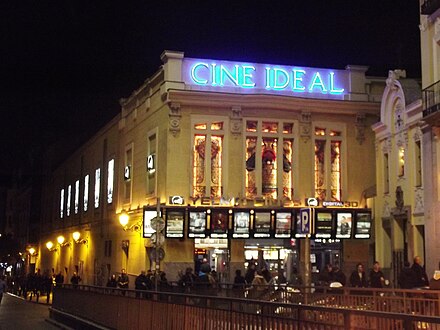
Festivals
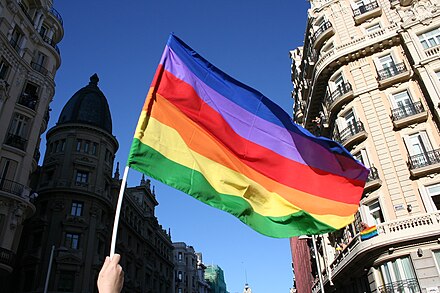
- La Trashumancia. Annual event during which the centre of Madrid is free of cars and is instead filled with shepherds exercising their ancient right to drive sheep and livestock through the city. 2022-12-05
- Madrid Gay Pride. Annual event held between the last week of June and the first of July, with more than 1.5 million people in the street from all around the world. It began as a weekend party, but lately turned into a full-week extravaganza.
Learn
If you want to go to Madrid to learn Spanish, there are several private language schools that offer Spanish courses for foreigners. These are listed in the district articles.
Another option is to take a Spanish course at university, the Complutense University of Madrid offers Spanish courses for foreigners that take place in the faculty of Philology and Letters.
Buy
_04.jpg/440px-Mercado_de_San_Miguel_(Madrid)_04.jpg) Major credit cards and foreign bank cards are accepted in most stores, but it is common practice to be asked for photo-ID (DNI). If asked for your DNI present your passport, residency permit or foreign ID card — anything with your photo and name on it will be accepted by most shopkeepers. The signatures on credit cards are usually not checked.
Major credit cards and foreign bank cards are accepted in most stores, but it is common practice to be asked for photo-ID (DNI). If asked for your DNI present your passport, residency permit or foreign ID card — anything with your photo and name on it will be accepted by most shopkeepers. The signatures on credit cards are usually not checked.

Shopping districts
In addition to the shopping areas below, there are also a lot of H&M, Zara, Mango, and Blanco stores all over Madrid, with high fashion clothes and accessories at a low price.
- Sol area, 40.4188°, -3.7048°. The most convenient area for tourists is around Calle de Preciados and Calle del Carmen, between metro stations Sol and Gran Vía, home to the El Corte Inglés department store, high-street names like Zara, Gran Vía 32, H&M, Sephora, Pimkie. 2017-04-08
- Salamanca, 40.4293°, -3.6863°. The most upscale shopping district is northeast of the centre, around Calle Serrano and its side-streets. Top designer names like Chanel, Versace, Hermès, Hugo Boss, Louis Vuitton, Emporio Armani and Dolce & Gabbana, including the fluid fabrics and elegant cuts of Spanish designer Adolfo Domínguez, are on Calle Ortega y Gasset. Head for Calle Serrano for Purificación García, Roberto Verino, Ermenegildo Zegna, Loewe, Carolina Herrera, Manolo Blahnik, Cartier, and Yves Saint Laurent. Prada is on Goya street, and on Jorge Juan St you can find even more luxury shops. 2017-04-08

- Chueca and Calle Fuencarral area, 40.423°, -3.7006°. This part of the city used to be an abandoned and marginal area. However, it has quickly turned into the most avant-garde and modern part of Madrid. Thanks to the gay community, old shops were taken over and turned into the coolest places of Madrid. Today it is an example of modernity, a paradise for entertainment where everything is possible. The streets are filled with restaurants, alternative cafés and shops, a good example is the Mercado de Fuencarral a novel shopping centre concept. Apart from the purely commercial, this area proposes a wide range of gastronomy and party clubs by night in the weekends. 2017-04-08
El Corte Inglés
_02.jpg/440px-El_Corte_Ingl%C3%A9s_Castellana_(Madrid)_02.jpg) El Corte Inglés is a Spanish institution, the only remaining department store chain in the country. El Corte Inglés stores are ubiquitous and dominate the retail market, setting the tone and reflecting the preferences of the Spanish customers. While hardly as exciting as visiting the over-the-top luxury department stores in New York or London, they provide a nice shopping environment, and many feature nice (and reasonably priced) food options. So, if the weather is bad, one of their stores may be your last resort.
El Corte Inglés is a Spanish institution, the only remaining department store chain in the country. El Corte Inglés stores are ubiquitous and dominate the retail market, setting the tone and reflecting the preferences of the Spanish customers. While hardly as exciting as visiting the over-the-top luxury department stores in New York or London, they provide a nice shopping environment, and many feature nice (and reasonably priced) food options. So, if the weather is bad, one of their stores may be your last resort.
Some of the more prominent El Corte Inglés locations in Madrid:
- El Corte Inglés Preciados, C/ Preciados 1-9, 40.41755°, -3.70477°, +34 913 798 000. Occupying the full first few blocks of the pedestrian boulevard Calle Preciados, El Corte Inglés serves as a gateway to the shopping paradise from Puerta de Sol. 2017-02-07
- El Corte Inglés Plaza de Callao, Plaza de Callao, 2, 40.41952°, -3.70506°, +34 913 798 000. M-Sa 10:00-22:00, Su 11:00-21:00. A much smaller store is to be found at the other end of Calle Preciados. Not quite a looker from the outside, it holds a top-floor restaurant with brilliant views over the Gran Vía. 2017-02-07
You will also find stores in Centro Comercial Serrano 📍, Centro Comercial Goya 📍 and Centro Comercial Princesa 📍, as well as in most shopping centres on the outskirts of Madrid.
Fashion
Loewe is one of the world's oldest luxury brands, founded back in the middle of the 19th century in Madrid. You will find their flagship stores Loewe Flores 📍 and Casa Loewe Madrid 📍 around the intersection of Calle Serrano and Calle de Goya, Loewe Gran Vía 📍 on Gran Vía, and, if you forgot something, two at the Madrid-Barajas Airport, in T1 and T4. If you are interested in flamenco, you can buy flamenco shoes at the store that makes the Sara Baras shoes
Markets
_7.jpg/440px-Rastro_de_Madrid_(Espa%C3%B1a)_7.jpg) Interesting markets can be found in the La Latina - Austrias and Retiro - Paseo del Arte districts
Interesting markets can be found in the La Latina - Austrias and Retiro - Paseo del Arte districts
Eat
Cuisine
See also: Spanish cuisine
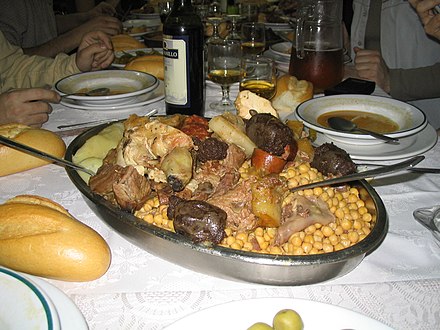 Dishes popular throughout Spain are also widely served in Madrid.
Dishes popular throughout Spain are also widely served in Madrid.
In addition, Madrid has a number of typical regional dishes:
- Gallinejas and entresijos – Lamb chitterlings fried in its fat. Very traditional and typical from Madrid city.

- Callos a la madrileña – A hot pot of spicy beef tripe similar to those found in Turkey and the Balkans.
- Cocido madrileño – Chickpea stew with meat and vegetables. The particularity of this stew is the way it is served. The soup, chickpeas and meat are served and eaten separately.
- Oreja de cerdo – Pigs ears, fried in garlic. This popular dish is widely eaten throughout central Spain.
- Sopa de ajo – Garlic soup is a rich and oily soup which generally includes paprika, grated Spanish ham, fried bread and a poached egg. A variation of this soup is known as sopa castellana.
It is ironic that Madrid, in the centre of Spain, has higher quality seafood than many coastal regions. This quality comes at a price, and most Spaniards only occasionally shell out for a mariscada or seafood feast. Experiencing Madrid's seafood may be, for the visitor, an experience which will be worth the cost.
Fresh meat and meat products (jamón ibérico, morcilla, chorizo etc.) are of generally a very high quality in Madrid.
Restaurants
Many of the restaurants and cervecerías in the Sol and Plaza Mayor area have generic poster board advertisements on the sidewalks with pictures advertising various paella dishes. These paellas are usually of bad quality and should be avoided. If you are looking for good, authentic Spanish paella, it is usually best to find a more expensive, 'sit-down' type of restaurant that offers a variety of paella dishes.
A much better option is the La Latina neighbourhood just south of Plaza Mayor, especially along Calle Cava Baja. There are also a number of deli-like shops along Calle Arenal that offer food to go (para llevar).
At bars, one generally orders various sized plates, a ración meaning a full dish, a media ración or a half-dish, or a smaller version which would be a tapa, a pinxto or a pincho.
The Spaniards don't eat lunch until 14:00 or 15:00, and dinner doesn't start until 21:00 or 22:00. As a rule of thumb, restaurants serve lunch from 13:00 until 15:30, then close and re-open for dinner at 20:00, serving until 23:00. This schedule is usually for restaurants, since bars and mesones are usually opened all day long offering a wide variety of tapas and sandwiches for a cheap price. If you're really desperate, the standard bunch of fast food chains do stay open throughout the day.
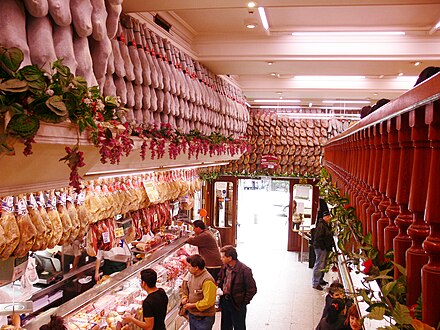
Drink
Tapas bars
In the tapas bars, you should get free food with your drinks. The highest concentration of tapas bars is in La Latina and around Plaza Santa Ana in the barrio de las Letras, but you will find them all over the city, including Malasaña and Chueca as well as the western districts, where there are probably less overrun by tourists.
- Calle Cava Baja, 40.4124°, -3.70922°. This narrow street in La Latina is by far the most famous and popular place for tapas. 2017-07-30
Cafés
Cafés and confectioneries can be found all over the city, but the highest concentration can be found around Puerta del Sol, barrio de las Austrias and Lavapiés, in the Old town and in Malasaña and Chueca. A very popular and typical local sweet that is sold both in cafés and by street vendors is Churros. These fried-dough pastries are distantly related to doughnuts, but have a more elongated shape and are a lot crispier. They are usually drizzled with sugar or chocolate.
Bars
_13.jpg/440px-Puerta_del_Sol_(Madrid)_13.jpg) Nightlife starts later in Madrid, with most people heading to the bars at 22:00-23:00. One of the best options to enjoy the nightlife is in the popular quarter Barrio de las Letras, especially on its main street, Calle Huertas, and other nearby streets. A great choice of bars is also available in the more traditional La Latina area as well as in the younger and alternative-flavoured Malasaña and Chueca districts.
Nightlife starts later in Madrid, with most people heading to the bars at 22:00-23:00. One of the best options to enjoy the nightlife is in the popular quarter Barrio de las Letras, especially on its main street, Calle Huertas, and other nearby streets. A great choice of bars is also available in the more traditional La Latina area as well as in the younger and alternative-flavoured Malasaña and Chueca districts.
Draught beer (cerveza) is usually ordered in cañas (200 ml), but may also come in dobles (400 ml) or jarras (mugs).
Clubs
Clubs generally open at about midnight. If you go in any earlier you may find it quite empty. Many clubs do not close until 06:00, and even then everyone is still full of life.
Nightlife areas
- Alonso Martínez - Many pubs and small discos. Until about 03:00, a very young crowd, and if you′re around here before midnight, and over the age of 20, prepare to feel positively old. Most places close around 03:00, then people move to clubs in Gran Vía or Tribunal to continue partying.
- Chueca - Near Malasaña and Gran Vía, it is known as the gay district, but doesn't exclude straight people. Pop and electronic music. By far, the most cosmopolitan place in town. Has become quite chic and expensive.
- Tribunal/Malasaña - Alternative area. Mainly rock and pop music clubs, some of them still open from "La movida madrileña" (beginning of the 1980s). Calle Manuela Malasaña is a great place to eat, Calle del Pez a great place to have some drinks and Plaza Dos de Mayo is the heart of the district.
- Gran Vía - "The place that never sleeps". Major street that includes many popular nightclubs, usually open from 01:00 to 06:00-07:00.
- La Latina - Near Lavapiés, it is the place to go for tapas and full of bohemian young people looking for stylish bars. In the old section are many small bars and pubs catering to people in their late 20s and 30s). Multiple bars serving fantastic tapas in the Cava Baja and Cuchilleros.
- Lavapiés - Multicultural quarter of the city, with more than 50% foreign residents, mostly from Africa, Asia and Latin America. Plenty of world music bars. Lavapiés is maybe the most cosmopolitan and hippy area at the same time in Madrid.
- Moncloa/Ciudad Universitaria - Due to its proximity to Universidad Complutense, Moncloa is associated with students and a student lifestyle, with many cheap bars and discos. Some of the places are best avoided. There are a few cheap bars with great nightlife starting from Thursdays directly in the Ciudad Universitaria near the major student dorms.
- Torre Europa - There used to be several posh pubs and clubs under the tower across from the stadium. There are four or five bars and discos in the avenida de Brazil area catering to a young and student crowd.
Sleep
While of course it is most convenient to have an accommodation close to the sights in the city centre, you should also consider hotels or apartments in the other districts. For example, Malasaña and Chueca are just 1 km north of the city centre, Chamberí 2 km, but the rates may already be noticeably lower. When travelling as a family or small group, you may also think about renting an apartment via AirBnB or similar sharing platforms. They are usually located in residential neighbourhoods and include a kitchen, so you can do your shopping on markets, supermarkets or alimentación stores and prepare some meals yourself. That way you may experience more of the Madrilenians' everyday life and reduce the total cost of your stay significantly. You will also find restaurants in these districts catering to locals rather than tourists.
Hostels
Cheap hostels starting from €8 for a dorm bed can be found near Plaza de España, in Lavapiés or the Sol area. There are also a bit more comfortable hostels offering single rooms for €30–40, doubles for €40–50, e.g. in Malasaña or the barrio de las Austrias.
Budget
Budget hotels and B&Bs charge around €30–60 for single, €55–100 for double rooms. Many of them can be found in the Barrio de las Letras or Chueca district.
Mid-range
A room in a mid-range hotel will cost you around €60–150 per night. Most of them are concentrated in the Barrio de las Letras and Sol area as well as the Paseo del Arte.
Splurge
A stay in a plush hotel will set you back at least €90 per night and there is no upper limit. Most of them are found in the posh Salamanca district, along the Gran Vía, in the historic centre and in the Retiro and Paseo del Arte area. Among the most famous names in the business are the Hotel Villa Magna, the Gran Meliá Palacio de Los Duques and the Madrid Ritz.
Connect
As of Sept 2021, Madrid has 5G from all Spanish carriers.
Locutorios (call shops) are widely spread in Madrid near touristy locations and are very cheap to use. Some shops and kiosks have tourist SIM cards from carriers like Orange and Vodafone with plans that run €10–20 for a month of 50–100 gigabytes of data or more. Employees are willing to install the card and configure the plan.
Prepaid portable Wi-Fi hot spot service is now available in Spain (provided by trip NETer (dead link: February 2023)), allowing the connection to any Wi-Fi device.
Cope
Embassies
| | | | style="width:50%;" | - 🇩🇿 Algeria, Calle del Gral Oraá, 12, +34 91 562 97 05. M-F 09:00-14:00. 2017-11-05 - 🇦🇩 Andorra, Calle de Alcalá, 73, +34 91 431 74 53. M-Th 09:00-17:00, F 08:00-14:00. 2017-11-05 - 🇦🇷 Argentina, Calle Fernando el Santo, 15. M-F 08:30-13:00 to submit documents and till 16:00 to return documents and telephone inquiries. 2017-11-05 - 🇦🇺 Australia, Torre Espacio, Paseo de la Castellana, 259D, Planta 24, +34 91 353 6600. - 🇦🇹 Austria, Paseo de la Castellana, 91 - 9º planta, +34 91 556 5315. - 🇧🇪 Belgium (Bélgica), Paseo de la Castellana, 18, +34 91 577 6300, madrid@diplomatie.fed.be. M-F 09:00-14:00. - 🇧🇷 Brazil (Brasil), Calle Fernando el Santo, 6,, +34 91 700 4650. M-F 10:00-14:00 and 16:00-19:00. 2017-11-07 - 🇨🇦 Canada, Torre Espacio, Paseo de la Castellana, 259D, +34 91 382 8400, madrid@international.gc.ca. M-F 09:00-12:30. - 🇨🇱 Chile, Calle de Lagasca, 88 - 6º planta, +34 91 431 9160. M-F 11:00-19:30 and Sa 11:00-15:00. The consulate is at Rafael Calvo, 18 – 5° D; +91 34 319 0763 or +91 34 319 9559 2017-11-07 - 🇨🇳 China, Calle Arturo Soria, 113, +34 91 5194242, chinaemb_es@mfa.gov.cn. - 🇨🇴 Colombia, Paseo del General Martínez Campos, 48, +34 91 700-4770. 2017-11-05 - 🇨🇺 Cuba, Paseo de la Habana, 194, +34 91 506 3111. M-Th 09:00-12:30. 2017-11-07 - 🇩🇰 Denmark (Dinamarca), Calle Serrano, 26 - 7º planta, +34 91 431 8445, madamb@um.dk. - 🇪🇨 Ecuador, Calle Velázquez No.114 – 2º. Derecha, +34 91 562 7215, +34 91 562 7216. M-F 09:30-14:30 and 16:00-18:30. 2017-11-05 - 🇸🇻 El Salvador, Paseo de la Castellana, 178, +34 91 562 8002. M-F 09:00-14:00. 2017-11-07 - 🇪🇬 Egypt (Egipto), Calle Velazquez 69, +34 91 5776 308, embmadrid@mfa.gov.eg. M-F 09:30-16:30. - 🇫🇮 Finland (Finlandia), Paseo de la Castellana 15 E, +34-91 319 6172, sanomat.mad@formin.fi. M-F 09:30-13:30. - 🇫🇷 France (Francia), Calle de Salustiano Olózaga, 9, 40.4208°, -3.6899°, +34 91 423 8900. M-F 09:30-13:30 and 15:30-18:30. - 🇬🇪 Georgia, Plaza de las Cortes N4, piso 5, Madrid, 28014, 40.415876°, -3.695634°, +34 91 429 01 55, embassymadrid@mfa.gov.ge. M-F 10:00-18:00. - 🇩🇪 Germany (Alemania), Calle de Fortuny, 8, +34 91 557 9000. M-F 09:00-12:00. - 🇬🇷 Greece (Grecia), Avda Dr. Arce 24, +34 91 5644 653, +34 6854 02800 (emergencies), gremb.mad@mfa.gr. - 🇬🇹 Guatemala, Calle Fernando el Santo, 27, +34 91 344 0347. M-F 10:00-14:00. 2017-11-07 - 🇭🇳 Honduras, Paseo de la Castellana, 164, +34 91 353 1806. M-F 09:00-14:00. The consulate is at Avenida Alberto Alcocer 7, entresuelo izq., +34 91 063 69 26 2017-11-07 - 🇮🇳 India, Avenida Pio XIII, 30-32, +34 91 209 8870. M-F 09:00-13:30 and 14:00-17:30. - 🇮🇩 Indonesia, Calle de Agastia No. 65, 28043, 40.448392°, -3.653817°, +34 413 0294, +34 413 0394, +34 413 0594, +34 413 0747, kbri@embajadadeindonesia.es. - 🇮🇪 Ireland (Irlandia), Paseo de la Castellana, 46-4, +34 91 436 4093. - 🇮🇱 Israel, Calle de Velázquez, 150, +34 91 782 9500. | style="vertical-align:top;width:50%;" | - 🇮🇹 Italy (Italia), Calle Lagasca, 98, 40.432471°, -3.684057°, +34 91 423 33 00. The consulate is at Palazzo di Santa Coloma - Calle Agustín de Betancourt n.3. 2017-11-07 - 🇯🇵 Japan (Japón), Calle Serrano, 109, +34 91 590 7600. - 🇰🇪 Kenya (Kenia), 3rd Floor, Calle Jorge Juan, 9, +34 91 781 2000, info@kenyaembassyspain.es. - 🇱🇾 Libya (Libia), Av. Comandante Franco, 32, +34 91 345 55 37. 2017-11-07 - 🇱🇺 Luxembourg (Luxemburgo), Calle Claudio Coello, 78, +34 91 435 9164, madrid.amb@mae.etat.lu. - 🇲🇽 Mexico, Carrera de S. Jerónimo, 46, +34 91 060 9857. M-F 09:00-13:00. 2017-11-05 - 🇲🇦 Morocco (Marruecos), Calle de Serrano, 179, +34 91 563 10 90. M-F 09:00-16:00. 2017-11-05 - 🇳🇱 Netherlands (Países Bajos), Paseo de la Castellana, 259, +34 91 353 7500, mad@minbuza.nl. M-Th 09:00-17:00, F 09:00-16:30. 2018-11-20 - 🇳🇿 New Zealand (Nueva Zelandia), Calle del Pinar 7, Planta 3a, +34 91 523 0226, madrid@embajadanuevazelanda.com. - 🇳🇬 Nigeria, Calle del Segre, 23, +34 91 561 3797. - 🇳🇴 Norway (Noruega), 5th Floor, Calle Serrano, 26, +34 91 436 3840, emb.madrid@mfa.no. M-F 09:00-15:00. - 🇵🇰 Pakistan, Calle Pedro de Valdiva, 16, +34 91 345 8995, cancilleria@embajada-pakistan.org. - 🇵🇹 Portugal, Calle de Lagasca, 88 - 4º planta, +34 91 782 4960 (embassy), +34 91 577 3585 (consular section). M-F 09:00-15:00. 2017-11-05 - 🇵🇭 Philippines (Filipinas), Calle Eresma, 2, +34 91 782 3850, info@philembassymadrid.com. M-Th 09:00-13:30 and 15:00-17:00. - 🇵🇱 Poland (Polonia), Guisando 23 bis, 28035, +34 913 736 605, madryt.amb.sekretariat@msz.gov.pl. M-F 09:00-17:00. - 🇷🇴 Romania, Avenida de Alfonso XIII 157, +34 913454553, madrid@mae.ro. 2021-12-03 - 🇸🇬 Singapore (Singapur), Avenida de Bruselas 28, +34 91 662 9373, hcgmadrid@fmetropoli.org. M-Th 09:00-14:00 and 15:00-18:30, F 09:00-15:00. - 🇿🇦 South Africa (Sudáfrica), 6th Floor, Calle Claudio Coello. 91, +34 91 436 3780, madrid.embassy@dirco.gov.za. - 🇸🇪 Sweden (Suezia), Calle Caracas, 25, +34 91 702 2000, ambassaden/madrid@gov.se. - 🇨🇭 Switzerland (Suiza), Calle de Nuñez de Balboa, 35A, +34 91 436 3960. M-F 09:00-13:00. - Taiwan (Oficina Económica y Cultural de Taipei), Calle Rosario Pino 14-16, +34 91 571 8426. - 🇹🇳 Tunisia (Túnez), Av. de Alfonso XIII, 64, +34 91 447 3508. 2017-11-07 - 🇬🇧 United Kingdom (Reino Unido), Torre Espacio, Paseo de la Castellana, 295D, +34 91 714 6300, spain.consulate@fco.gov.uk. M-F 08:30-13:30. - United States (Estados Unidos), Calle Serrano, 75, +34 91 587 2200. * Venezuela, Calle del Poeta Joan Maragall 1, Planta 13, +34 91 598 12 00. 2017-11-05 |
Newspapers
There are a number of free, English language periodicals that you will find in bars and restaurants that are a great source of event information.
Stay safe
Madrid is a very safe city, with some of the lowest crime rates among Europe's largest cities. The police is highly visible, and the city is equipped with cameras. There are always people in the streets, even at night time, so you can walk across the city generally without fear. Travellers who remain aware of their surroundings, and keep an eye on their belongings, should have little to worry about.
Neighbourhoods and suburbs
As with any place on earth, there are parts of Madrid and its metropolitan area that are less appealing and, consequently, less safe than others.
- Broadly speaking, the northern and western areas of Madrid and its suburbs are very safe.
- Several streets north of Gran Via, though very lively, have been known to attract seedy crowds at night.
- Some Madrid neighbourhoods in the south (especially Carabanchel and Puente De Vallecas) and east (Ciudad Lineal) are marginally less well-off, and they can give off an uneasy vibe to those unfamiliar with these areas. They are safer than many "bad neighbourhoods" in other western European countries, but be on your guards at night. Most places near metro stations are safe.
- Likewise, certain suburbs to Madrid's south (Móstoles, Getafe) and east (Alcala de Henares) have reputations as working-class communities with dodgy characters. This is not entirely accurate, but it is always wise to stick to well-lit and crowded streets.
Football
Despite the notoriously intense and politically-charged rivalry between Real Madrid and FC Barcelona, most people will not care if you wear an FC Barcelona football shirt, and in fact you will often see people (usually tourists) wear that shirt around the city. As Madrid is the capital city of Spain, it attracts people from all over the country, including Catalonia. One notable exception: on match days, do be careful, as violence has been known to occur between supporters of both clubs.
Furthermore, there is a love/hate relationship between the two major football clubs in the city: Real Madrid and Atletico Madrid. Both are storied clubs with diverging identities; Real Madrid was always seen as the club of the elite, whereas Atletico Madrid is seen as the "people's club". Many fans and analysts believe that the "Derbi Madrileño" is more entertaining than "El Clasico", partially because of those differences in identity, but also because fans of the clubs have been known to engage in fiery arguments. If you ever see Real and Atletico fans argue, be careful if things start to escalate.
Pickpocketing
Much like other big European cities, Madrid has its fair share of nonviolent pickpocket crime, though it is nowhere near the stratospheric levels of cities like Rome or Barcelona. Always watch out for any belongings (mostly bags and wallets) you have with you, especially on the Metro and in busier public spaces. Some areas with acute pickpocketing problems include Gran Via (especially near Plaza de Callao and Calle de Fuencarral), Puerta del Sol, the Atocha train station, and the AZCA business district (though the latter has seen improvements in that regard). Some major night clubs like Kapital and Mondo Disko also attract pickpockets.
Pickpockets often create a distraction while an accomplice steals from you. Distractions include presenting a map and asking you for directions, or asking you to sign a petition - which is followed by a request for a donation. It is best to ignore any stranger that approaches you in the street asking for help. Be careful when carrying luggage as this can make you a target for pickpockets.
One prevalent and long-lasting issue in Madrid are street vendors, especially around Puerta del Sol. They are usually harmless and will take "no" as a sign that they should not bother you, but do not provoke them. Also, these street vendors react swiftly to police cars, so watch yourself whenever they run from the police.
At bars and restaurants never leave wallets or telephones on the table as possessions on show make for easy targets. Passing thieves create a distraction and steal the items. The area around Calle de las Infantes near Gran Via is particularly renowned for this.
When using ATM machines, be aware of your surroundings, just as you would anywhere. Bring a friend if you need to withdraw cash after dark. If someone approaches you while using an ATM, hit CANCELAR, retrieve your card and move on.
When going out, getting drunk can make you a target for thieves. Also keep an eye on your drink. Don't carry valuables on a night out.
Scams
Plaza Mayor and Puerta del Sol might be beauties to look at, but they are Meccas for scams.
Avoid people offering massages (masajes); this is often a scam to extort money. Be firm and say "No me toque" ("Don't touch me") or "No tengo dinero" ("I don't have any money")
Go next
While Regional and Cercanías tickets don't have to be pre-bought and don't sell out, tickets for AVE, Avant and other long distance trains sell out once all seats are gone. if you want to take a day trip to Sevilla or want to take one of the faster trains to Segovia, buy your tickets in advance.
Easy day-trips from Madrid include :
- Alcalá de Henares is a charming old university town, birthplace of Miguel Cervantes the author of Don Quixote. Reach it by local train within 50 min.
- Aranjuez has the Palacio Real, the Bourbon monarchs' summer home, and the lavish Casa del Labrador near the river. Local trains take 45 min from Atocha, 55 min from Chamartin.
- Ávila has the most intact walled old town in Spain, spectacular when floodlit at night. Fast trains from Chamartin take 90 min.
- Chinchon is a hilltop small town that retains its character from the 1700s. No train, drive or take the bus.
- El Escorial is a huge monastery and palace, the Royal Monastery of San Lorenzo de El Escorial. Reach it within an hour by local train from Atocha or Chamartin. Near El Escorial is Spain's most controversial monument - Valle de los Caìdos. Built by Spanish republicans taken prisoner during and after the civil war, it is a gigantomanic underground church with a huge cross on top of the mountain an edifice very much in the fascist style. It is the burial place of many fallen of the civil war, and it housed the tomb of dictator Francisco Franco until October 2019. There's an infrequent public bus to the entrance, from where it's another 9 km hiking. The nearby mountains, Sierra de Guadarrama, are the setting for Peñalara Nature Park.
- El Pardo is a village 8 km from Madrid with the Palacio de El Pardo, which in 1739 hosted a peace conference between Spain and England. War broke out. A bus runs from Madrid Moncloa.
- Segovia is a medieval city perched on a hilltop, with a great Roman aqueduct leaping across the valley to bring in the water supply. It's 30 min by train from Chamartin.
- Toledo is a medieval walled city and former capital of Spain, with excellent architecture and artwork. It's 30 min by train from Atocha.
Further afield, day-trips at a stretch but deserving at least an overnight stay, are Salamanca, Leon, Valladolid, Zaragoza and Córdoba.
Madrid
madrid.esProvincia de Madrid
2nd-order administrative division
Community of Madrid
Primary administrative division
